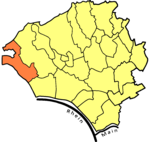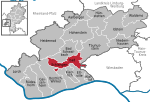Rhine-Taunus Nature Park
European protected area stubsHesse geography stubsNature parks in HesseRheingau

The Rhine Taunus Nature Park (German: Naturpark Rhein-Taunus), located in the Rheingau-Taunus-Kreis and Wiesbaden district of Hesse, Germany was founded in 1968. It includes the western part of the Taunus and extends over the Idsteiner Becken to the Rhine. It is characterized by a roughly 60 percent forested low mountain landscape, which falls away steeply toward the Rhine Gorge.
Excerpt from the Wikipedia article Rhine-Taunus Nature Park (License: CC BY-SA 3.0, Authors, Images).Rhine-Taunus Nature Park
Herzogsweg,
Geographical coordinates (GPS) Address Nearby Places Show on map
Geographical coordinates (GPS)
| Latitude | Longitude |
|---|---|
| N 50.13 ° | E 8.16 ° |
Address
Herzogsweg
Herzogsweg
65232 , Hahn
Hesse, Germany
Open on Google Maps






